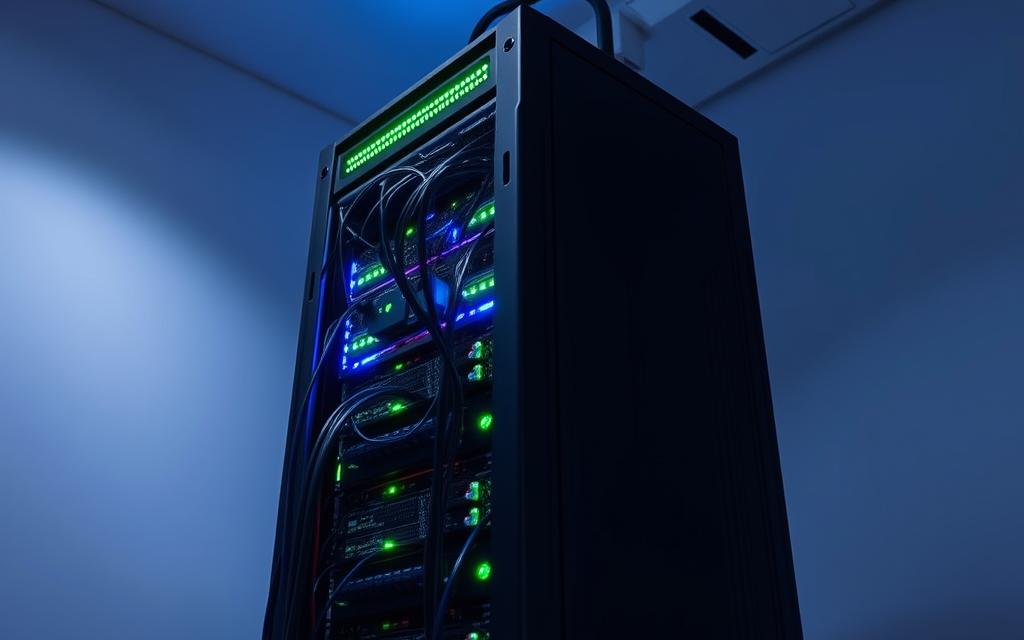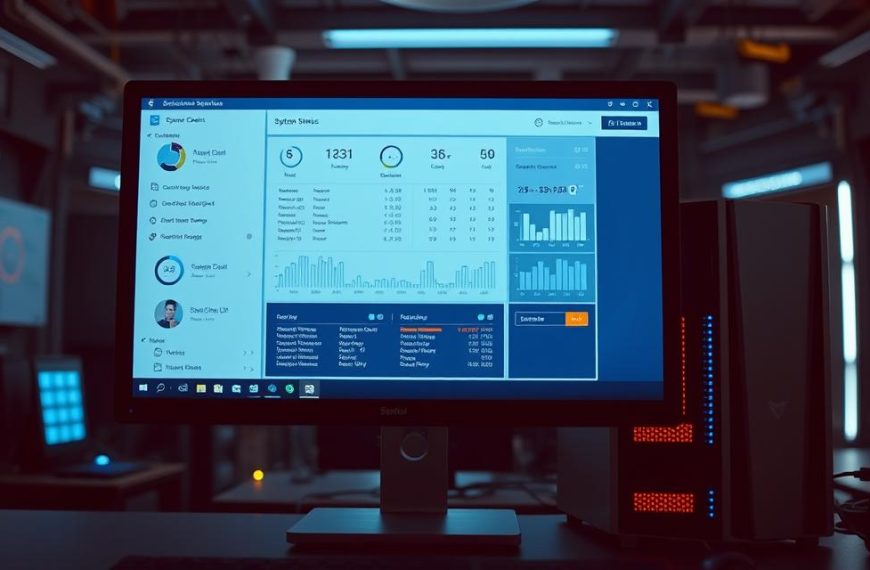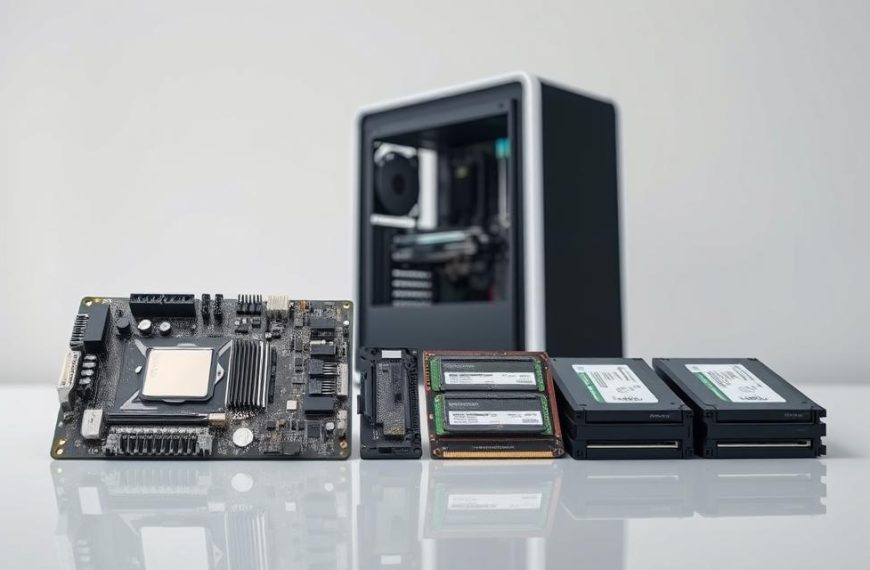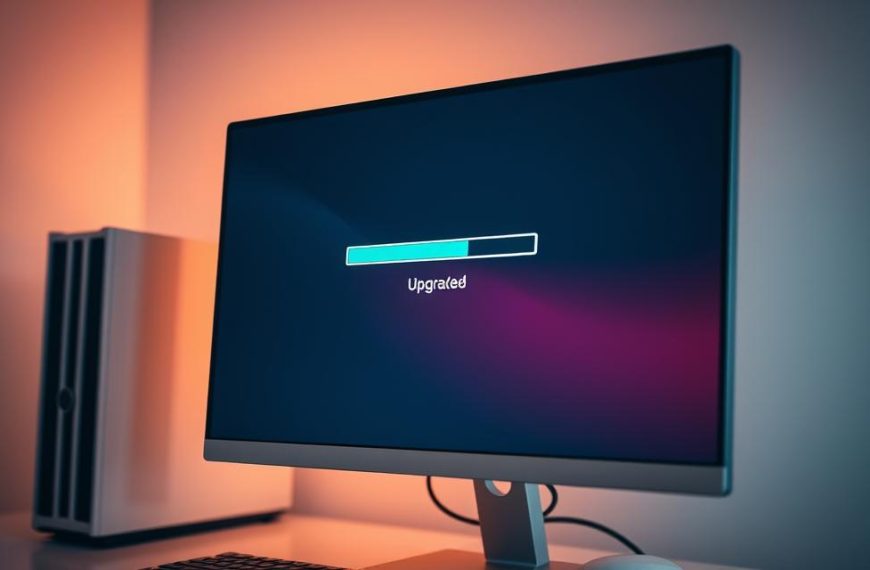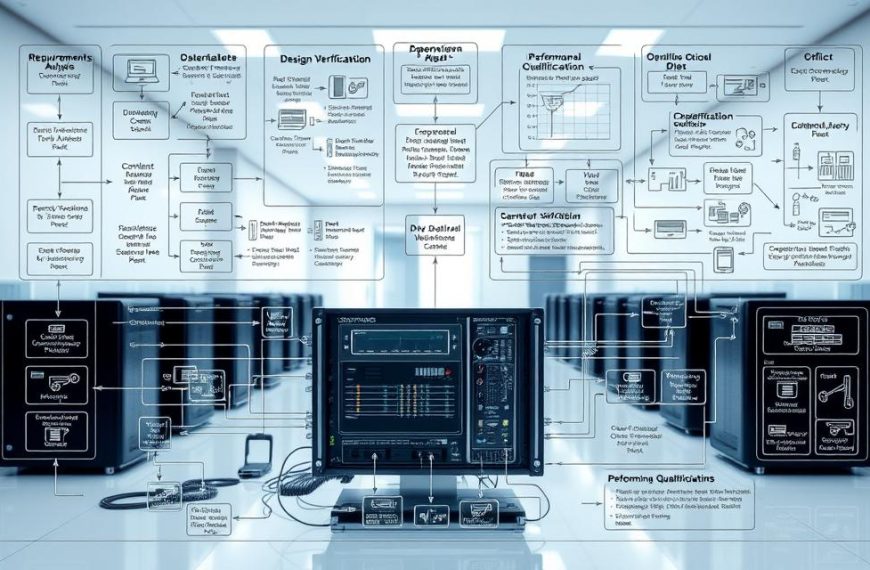Imagine a digital security guard between your network and the internet. It checks every piece of data trying to get in or out. It makes quick decisions based on strict rules.
This key part of computer security is called a firewall. It’s your first defence, controlling all network traffic. It stops unwanted access and lets safe communications through.
This important network security device sits at the network edge. It follows set security rules. It protects your computer system from threats outside.
A firewall checks and controls data packets. It makes sure only safe connections are made. This is a basic but vital part of keeping your digital world safe.
What is a Firewall on a Computer System?
A firewall is like a digital shield for your network. It checks all data coming in or going out. It acts like a security guard, deciding what traffic to let through and what to block.
Defining the Firewall Concept
A firewall is a network security system. It watches and controls network traffic. It keeps your internal network safe from the outside world, like the internet.
Modern firewalls use many ways to protect against cyber threats. They don’t just look at single packets. They understand the whole network connection, making them better than old firewalls.
Firewall technology has grown a lot. Now, they can do deep packet inspection and understand application-layer traffic. They even use threat intelligence to block new threats.
Historical Context and Evolution
Firewalls started in the late 1980s as networks connected to the internet. The first ones were simple and didn’t do much. They just looked at basic packet info.
In the 1990s, firewalls got smarter. They could track connections and make better decisions. This made them more useful for businesses.
The table below shows important milestones in firewall development:
| Time Period | Firewall Type | Key Capabilities | Limitations |
|---|---|---|---|
| Late 1980s | Packet Filtering | Basic address checking | No connection state tracking |
| Early 1990s | Circuit-Level | Session verification | Limited application awareness |
| Mid 1990s | Stateful Inspection | Connection state tracking | Resource intensive |
| 2000s-Present | Next-Generation | Application awareness, integrated threat intelligence | Complex configuration |
Today’s firewalls are the result of many years of work. They have advanced features like intrusion prevention and cloud integration. They’ve become key parts of network defence.
Firewall technology keeps getting better as cyber threats change. As new threats appear, firewalls get updated to keep up. This ensures they stay effective against new dangers.
Why Firewalls are Essential for Network Security
In today’s world, firewalls are key to keeping your network safe. They act as smart guards, checking all traffic coming in and out. This helps decide what’s allowed and what’s not.
Modern threats are getting smarter, making firewall protection a must. Firewalls offer several layers of defence. Together, they form a strong security plan.
Protecting Against Unauthorised Access
Firewalls are the first defence against intruders. They check each data packet, looking at its source, destination, and content. This is against set security rules.
This stops hackers and bad actors from getting into your systems. Firewalls block unwanted connections, closing doors for cybercriminals.
Advanced firewalls can also check data packets, making sure only real communications get through. This adds more protection against complex attacks.
Preventing Data Breaches and Cyber Threats
Firewalls also stop data from being taken out without permission. This is key against threats like ransomware and malware.
These threats try to send data to servers or steal it. Firewalls can spot and block these actions.
Firewalls fight off cyber threats by looking for known attacks and odd behaviour. This helps stop big security problems before they start.
Choosing the right firewall types means getting protection that fits your needs. This way, you’re ready for today’s and tomorrow’s digital dangers.
Types of Firewalls and How They Differ
Today, we have many types of firewalls to keep our networks safe. Each one works in its own way and offers different levels of protection. Knowing the differences helps us pick the best one for our needs.
Hardware Firewalls
Hardware firewalls are special devices that guard entire networks. They sit between your network and the internet. They check traffic before it gets to your devices.
These devices are very good at handling lots of traffic without slowing down your network. They’re great for big companies because they’re easy to manage.
Examples: Cisco ASA, FortiGate
Cisco ASA is a top choice for keeping threats away. It uses stateful inspection and has advanced malware protection. FortiGate firewalls do even more, like stopping intrusions and setting up VPNs.
Software Firewalls
Software firewalls live on computers or servers. They protect each device, letting you control what apps can do and who can connect. They’re perfect for personal use or to add extra protection to hardware firewalls.
They watch how apps behave and stop them if they try to do something bad. This keeps your network safe.
Examples: Windows Firewall, Norton Firewall
Windows Firewall is built into Windows, giving basic protection. Norton Firewall adds more, like watching apps and catching threats as they happen.
Next-Generation Firewalls (NGFW)
Next-generation firewalls are the latest in firewall tech. They do more than just check ports and protocols. They have deep packet inspection, know about apps, and stop intrusions.
These firewalls offer top-notch cyber threats protection. They can spot and block apps, even if they’re using weird ports. They also get updates from threat intelligence feeds to stay ahead of threats.
Choosing the right firewall depends on your network size, security needs, and budget. Many use a mix of firewalls for the best protection.
How Firewalls Work: Mechanisms and Technologies
Firewalls are key to keeping your network safe. They use smart ways to check and control data moving in and out. This helps protect your digital world.
Packet Filtering
Packet filtering is at the heart of firewall tech. It looks at each data packet trying to get into the network.
The firewall checks the packet’s details against set rules. It looks at where the packet is coming from and going to, and what it’s carrying. If it fits the rules, it goes through; if not, it’s blocked.
This method is fast and efficient. But it doesn’t understand the bigger picture of network connections.
Stateful Inspection
Stateful inspection is a step up from packet filtering. It keeps an eye on what’s happening in your network.
Unlike basic filtering, it remembers about ongoing conversations. It looks at the whole story of a packet, not just its single details.
This way, it can spot and block suspicious activity. It’s smarter than simple filtering.
Proxy Services
Proxy firewalls act as middlemen between networks. They add an extra layer of security. They work at the application level, at OSI model’s layer 7.
External requests first hit the proxy server. It checks the content before letting it through to your network.
This method is great for checking content thoroughly. It also keeps your network hidden, protecting your devices’ real addresses.
Each firewall technology has its own strengths. Modern firewalls use a mix of these to keep your computer safe.
Implementing a Firewall in Your System
Setting up a firewall needs careful planning and action. This guide helps you pick, install, and set up the right firewall for your needs.
Choosing the Right Firewall for Your Needs
Finding the right firewall involves looking at several key factors. It should meet your security needs without slowing down your network.
Think about your organisation’s security level. Small businesses might want something easy to use. Large companies need advanced security features.
How your network is set up is also important. The firewall must work well with your current setup without causing problems.
It’s also key to think about how the firewall will grow with your network. Choose a system that can grow with you.
How easy the firewall is to manage affects how well it works. Some are simple to use, while others need special skills. Pick one that fits your team’s abilities.
| Firewall Type | Best For | Management Complexity | Scalability |
|---|---|---|---|
| Hardware Firewall | Enterprise networks | High | Excellent |
| Software Firewall | Small businesses | Medium | Good |
| NGFW | Advanced protection | High | Excellent |
| Cloud Firewall | Distributed teams | Low | Outstanding |
Installation and Configuration Steps
Getting your firewall set up right is key to managing it well. Start by checking your network to see what you have and how things move.
Most firewalls follow a similar setup process:
- Install it physically or virtually as the maker says
- Use the default login details to start
- Set up your network interfaces and zones
- Make basic rules for important services
Configuring your firewall is the most important step. Windows Defender Firewall shows how to make custom rules to protect your data. You can block or allow certain apps and services.
Choosing your network profile is also important. Private networks let more traffic through, while public ones are stricter.
Creating a security policy is the final step. Make clear rules for incoming and outgoing traffic. Update these rules as your network changes.
Testing your setup before you use it is important. Make sure good traffic gets through and bad traffic gets blocked.
Keeping good records of your firewall setup is often overlooked but very important. It helps with troubleshooting and making changes later.
Remember, setting up a firewall is not a one-time job. You need to keep checking and updating it to keep your data safe as your network and threats change.
Best Practices for Firewall Management
Managing firewalls well means always keeping an eye on them, not just setting them up once. It’s important to keep them updated and maintained. This helps protect your network from new cyber threats.
Regular Updates and Monitoring
Firewall software needs updates to stay safe. Apply security patches quickly when they come out. This stops hackers from finding and using known weaknesses.
Watching your network all the time helps spot security issues. Check firewall logs every day for odd patterns. Use alert systems to quickly tell staff about strange traffic or attacks.
Check your firewall rules often to make sure they’re working right. Get rid of old rules that could be risky. Keep a record of any changes for future reference.
Keep an eye on how well your firewall is doing. Look at things like how many connections succeed and how fast they are. This helps keep your network safe and running smoothly.
Integrating with Other Security Measures
Firewalls are more effective when they’re part of a bigger security plan. Working together with other systems makes your network safer. This layered approach helps protect against many types of attacks.
Using firewalls with intrusion detection systems makes monitoring better. These systems can spot threats by looking at traffic patterns. Working together, they offer stronger security.
Adding endpoint security to your network firewalls helps protect devices. This keeps your devices safe even when they’re not on your network. It’s very helpful for people who work on the go.
Using SIEM systems helps you see everything happening on your network. They connect firewall data with other security logs. This makes it easier to spot complex threats.
Testing your security setup regularly is a good idea. Penetration tests can find weak spots in your defences. Use what you learn to keep your security strong.
Conclusion
Setting up a firewall boosts your network’s security and keeps your data safe. These systems act as strong barriers against unwanted access and cyber dangers.
When picking a firewall, you need to think about what you really need. Each type has its own benefits for keeping your computer safe.
To keep your firewall working well, you must set it up right and update it often. Firewalls are most effective when used with other security tools like antivirus software and systems that detect intrusions.
Even though firewalls have their limits, they are key to a strong security plan. They offer a vital first defence in our digital world.
Look at your current security setup and see how adding a firewall could help protect against data theft and cyber attacks.

